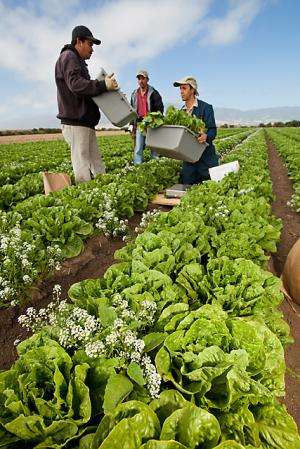In the field, the right flower arrangement can improve organic pest control

Studies conducted in an organic lettuce field managed by the U.S. Department of Agriculture (USDA) indicate that there's more to sweet alyssum than just good looks. Agricultural Research Service (ARS) horticulturist Eric Brennan has identified ways to improve how the pretty white flowers control aphid pests that prey on lettuce leaves. ARS is USDA's chief intramural scientific research agency.
Lettuce growers in California's central coast plant alyssum to attract adult hoverflies that feed on the flower's pollen and nectar. After eggs laid by the well-fed females hatch, the voracious larvae prey on currant lettuce aphids—an important primary insect pest of lettuce in the region. The aphids are particularly difficult to control because they colonize the interior leaves of the lettuce plant.
Brennan, who works at the ARS U.S. Agricultural Research Station in Salinas, Calif., wanted to figure out the most cost-effective alyssum planting patterns in lettuce fields to help organic producers maximize their profits. At a working research farm in Salinas that is certified for commercial organic production, he established experimental beds with eight different planting combinations of alyssum and romaine lettuce.
For two growing seasons, Brennan evaluated how alyssum biomass and flower production varied with alyssum planting density and how competition between lettuce and alyssum affected the biomass of both plants. In beds where alyssum had been planted in addition to a full complement of lettuce, the alyssum produced more blossoms per gram of alyssum dry matter.
This response indicated that the alyssum and lettuce planted in this pattern may have been in stronger competition for nutrients needed to support biomass production. But the resulting boost in blossoms increased alyssum's value as an insectary plant, which is a flowering plant cultivated in crop fields because it attracts insect predators to feed on pests.
Brennan has also concluded that randomly interspersing alyssum plants throughout all the lettuce rows could minimize competition between lettuce and alyssum and encourage adult hoverflies to forage for pollen and nectar more evenly throughout the field.
Results from this study were published in Biological Control in 2013.
More information: Read more about this work in the January 2014 issue of Agricultural Research magazine.
Journal information: Agricultural Research
Provided by Agricultural Research Service


















